by
Rhythm Scene Staff
| Nov 30, 2022
I had the opportunity to study with Billy Martin at the Atlantic Center for the Arts in October 2020. Still early in the pandemic, this was one of my first in-person musical opportunities since March of that year. I and six additional cohort musicians joined Billy for a three-week residency at ACA in New Smyrna, Florida. During the residency, Billy created compositions, led improvisations and performances, hosted film screenings, and completed some recordings. It was a productive and much needed musical and artistic experience for all involved.
Emerging out of the music scene in New York City in the 1980s, Billy formed the Medeski Martin and Wood trio. “Bridging the harmonic complexity of jazz, the conversational fluency of free improvisation, and the groove and swagger of classic R&B and funk,” the group is internationally known for their records and live performances. Billy is also an accomplished composer, filmmaker, and visual artist. He is currently Executive Artistic Director and CEO of Creative Music Studio, and he also owns and manages his own record label, Amulet Records. You can learn more about Billy and his work at www.billymartin.net.
My interview with Billy took place on October 29, 2020.
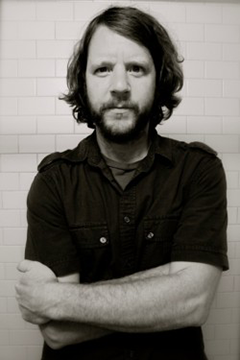 Thad Anderson: A lot of your personal sound is rooted in your own collection of instruments and found sounds. Can you talk about collecting sounds and how these unique instruments influence your playing?
Thad Anderson: A lot of your personal sound is rooted in your own collection of instruments and found sounds. Can you talk about collecting sounds and how these unique instruments influence your playing?
Billy Martin: I hold all of my sounds sacred to me and they are very personal. Half of them are found instruments — things I may find in a junkyard, in the garbage, or at a construction site. Scrap metal is something I am always tapping and listening to — the tonal quality of metal sound, particularly. And then there are all kinds of wood. There are so many sounds from different cultures where there might be West-Central African slit gongs and things like that, temple blocks from Asia, shells, seed pods. As a percussionist, the world is just a candy store of sound. Also, bamboo and things like that; I grow bamboo. So those sounds become sort of like my personal palette of colors and rhythms and timbre. I think it's really important to put together your own personal sounds, and that really informs what I'm going to play. Sound is really important to me. It's not just the note to compositional material that I'm thinking of; the sound can actually help me play a different way, and so that's a really integral part of my playing.
Anderson: Implements, too; you have a lot of either custom or homemade sticks and mallets and different objects that you use as a means for producing sound. This is along the same lines as far as building your own custom sound, correct?
Martin: Yeah, definitely. Implements, that's a good word because I didn't realize what they are as opposed to mallets and sticks. They’re implements. You can’t have one metal bar to strike things. It's nice to have a really thin piece of metal, a bent piece of metal, because you're not only using it to strike things. They have a certain density and a length to them that affects your performance, but also it might have a surface of its own that you can scrape with; you can get overtones by scraping it on something else, or vibrating. Then there are all kinds of experimental brush mallets, things that are made out of wicker, bamboo, all kinds of different fabrics and things.
l have a lot of maple trees in my yard, and the branches fall and I find the right size that is sort of like a large dowel you might use for Taiko drumming or something. I was inspired by the Burundi drummers in Africa. So yeah, all those things really do have an effect. For example, the big fat dowels that might be used for Taiko drumming, if I play the drum set with that, it's really going to bring out a different kind of tone and put me in a different kind of place to play. So yeah, the implements are as important.
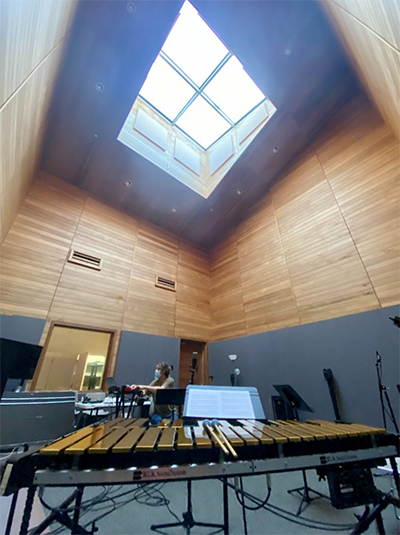
Billy Martin working in the recording studio at the Atlantic Center for the Arts, October 2020; pc Thad Anderson
Anderson: I know Brazilian music has had a big influence on you. You're a world traveler and you've been all over the planet playing music. How do you use the traditions of other cultures and other folkloric music to merge it into your own musical voice and style?
Martin: I use folkloric music, the vocabulary of different people's music, just like I do anything else. I sort of hear it. I may play along with it or get to know it musically by performing certain things, phrases, and tonalities. I don't necessarily study it thoroughly like an ethnomusicologist or someone who is studying Balinese gamelan or something. It's more like an impression to me. I listen to a lot of music — a lot of records from all over the world, the folkloric music from as many cultures as I can because I'm always looking for another dimension or another way of expression and it often comes from the folkloric cultures. It also can sort of stretch into the avant-garde performance because when you mix up some of these melodies and rhythms, it becomes part of your language. So as an improviser, as an experimental artist, I absorb them however I may. Sometimes it's just through listening, and then it makes me play differently. Other times it's like sitting down and really figuring out “What are these notes?” and “How do you play it?” So you're building a vocabulary.
A lot of stuff for me is informed from folkloric music, particularly African, Yoruban, parts of West Africa, North Africa, and Central Africa, and then all of that is going to Brazil, Haiti, the Caribbean, and New Orleans. Then there is Balinese gamelan and Hawaiian and Japanese, all these different cultures that are really inspiring. Also, there’s vocal music from Georgia the country. Bulgarian singers, that stuff influences my playing even though it's not rhythmic. It has some kind of effect on my playing.
Anderson: When it comes to improvising you've talked about this concept of beginner’s mentality. Is this something you are aware of as a younger musician and artist or do you feel like it came more into focus as you grew more experienced and had more experiences?
Martin: When I was younger, I wasn't aware of the beginner's mind, the kind of playfulness that leaves things open to letting things happen and being playful and not so serious and closed-minded. That's the wisdom of getting older as an artist, I think. You start to look back and realize that the child's mind, you've experienced it, you give a little child that can barely walk a mallet and you let them hit the cymbal and then you see their eyes open up and they look around the room and they're like “Did I just do that?” And that's the wonder and the beginner's mind of playing music and being so blown away by the sound that you're creating. It's that simple, as opposed to thinking too much intellectually and comparing yourself to others, referencing things. No, beginner's mind, it's like zero. Put yourself in that place; you're hearing these sounds for the first time and you can go in any direction you want. That's the beginner's mind. There's no structure. You create the structure as you go along. You do control it as you improvise.
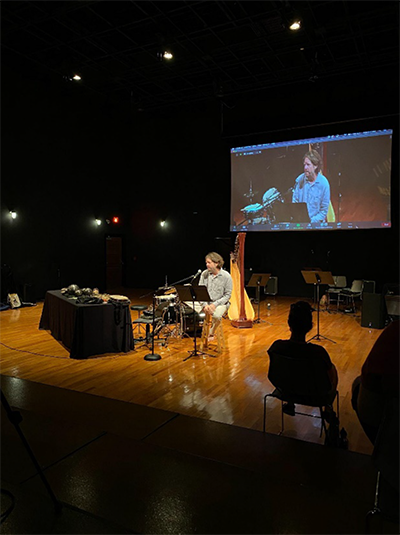
Billy Martin giving an artist talk as part of residency #179 at ACA, October 2020; pc Thad Anderson
Anderson: Do you feel like you had to get to a place with your own artistic expression and your own voice before that became clearer? Not a specific moment in time necessarily, but as a younger player, potentially you're concerned about what everyone else is thinking around you. Do you feel like it took time to root yourself in your own voice before that took shape, I guess, before you were able to let go?
Martin: Absolutely. I went through hell and back. I mean I went through a lot of pain and suffering and humiliation that was really brought on myself mostly. Just being so self-conscious and comparing myself to others and feeling like a failure and also going into places where I was kind of failing. But those were enlightening, too; those were turning points for me. It was like, “Why do I feel so bad about it? Why do I feel like I don't fit in? Why didn't this work?” And then over time all that thinking got in the way, so it's a lifetime of experience. I'm in my late 50s now, and I have to say, it has everything to do with time and experience and experimenting with different ways to explore your heart, explore the areas that you really want to explore even if you don't think you're good enough. You’ve got to try, and then from there things start to open up and you start to realize there is a way, but it just doesn't come naturally, it doesn't come at the beginning; it comes with experience.
Anderson: How does your visual art influence your music making, improvising, and composing? To me the connection is apparent through your graphics scores, but I'm wondering if there's any further relationship between what you do with visual art and your music?
Martin: I've come to the conclusion that it comes from the same place. It's like a playfulness of improvising and experimental spirit. Whether you're just making an image or you're making a line with a crayon or a pencil or a brush stroke, and then you react to that by starting to shape that into a form. You're following this unknown path, but your mind is working in a way that's shaping something; you’re sculpting something in a sense. And that's the same with improvising: you make a sound and then you just follow that sound with another sound. It either turns into a groove rhythm and you start expressing something on a timeline or a specific pulse, or you're just creating something melodic. It's all composition in a sense that you're just following your intuition.
For me, visual art and music are really a very similar process. The medium is just different. Music is there and it's gone, in a sense, if you don’t record it. It gets fixed if it's recorded, then you can listen back to it, and with visual art, obviously you can create something on paper and then you can look at what you're doing. You can stop and come back tomorrow and finish your painting or just go over it and do it again. It's really the same.
Anderson: The last question is about upcoming projects and things you have in the works. I know there are some Creative Music Studio projects coming up, but what other projects are on the horizon?
Martin: I just finished this Guilty record that I released. It's called Guilty and it's just whatever you think that means to you, which is mostly how I have people interpret my music. I want you to come to whatever it means to you. This record was created by experimenting with bass lines, finding bass riffs, and looping them and then playing the drums and building from there. Then I got some great players after I created a form and stuff. I brought some other people in.
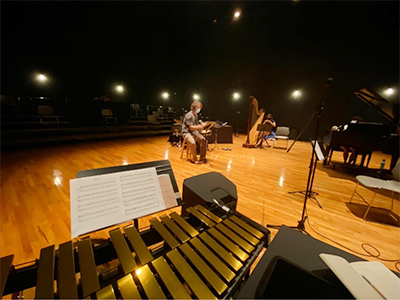
I think I'm going to make another record like that. It may go into the direction of exotica because as a percussionist those records are really cool. So, I might play around with that because it's so simple and so moody. That's the one thing about that record; it’s very moody and there's something about the simplicity of that and getting back to groove-based stuff for me. I think it's nice to kind of have that opportunity.
I don't know when Medeski, Martin, and Wood are going to release a record that we recorded years ago. It was during a filming of a documentary about making a record, and the film was about following us through the process of creating together. So, we ended up recording this record. That will probably come out, hopefully early next year.
I'm composing a lot of music as you know; you have been part of it these three weeks. I'm hoping to realize that. I’m not sure where I’m at with that, but I’m probably going to think really hard about what’s the next step for me for a chamber music record. Some of that material may end up on there. Who knows, I may rearrange it. I’ll continue to work with Creative Music Studio. I learn a lot from teaching and I learn a lot from listening to other teachers’ philosophies on improvising and being creative, and the Creative Music Studio has definitely been a great learning experience for me. So, there are a couple of records coming up, maybe three. I just finished an Italian documentary film score about Marco Pantani, the great bicycle racer, and that’s going to come out next year.
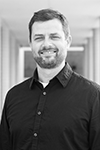 Thad Anderson is an Associate Professor of Music at the University of Central Florida, where he coordinates the Percussion Studies program, teaches applied lessons, and directs the UCF Percussion Ensemble. Anderson is also artistic director of the UCF New Music Ensemble and teaches courses in music technology. Anderson is a versatile performer and pedagogue with focused interests that involve contemporary music and technology.
Thad Anderson is an Associate Professor of Music at the University of Central Florida, where he coordinates the Percussion Studies program, teaches applied lessons, and directs the UCF Percussion Ensemble. Anderson is also artistic director of the UCF New Music Ensemble and teaches courses in music technology. Anderson is a versatile performer and pedagogue with focused interests that involve contemporary music and technology.